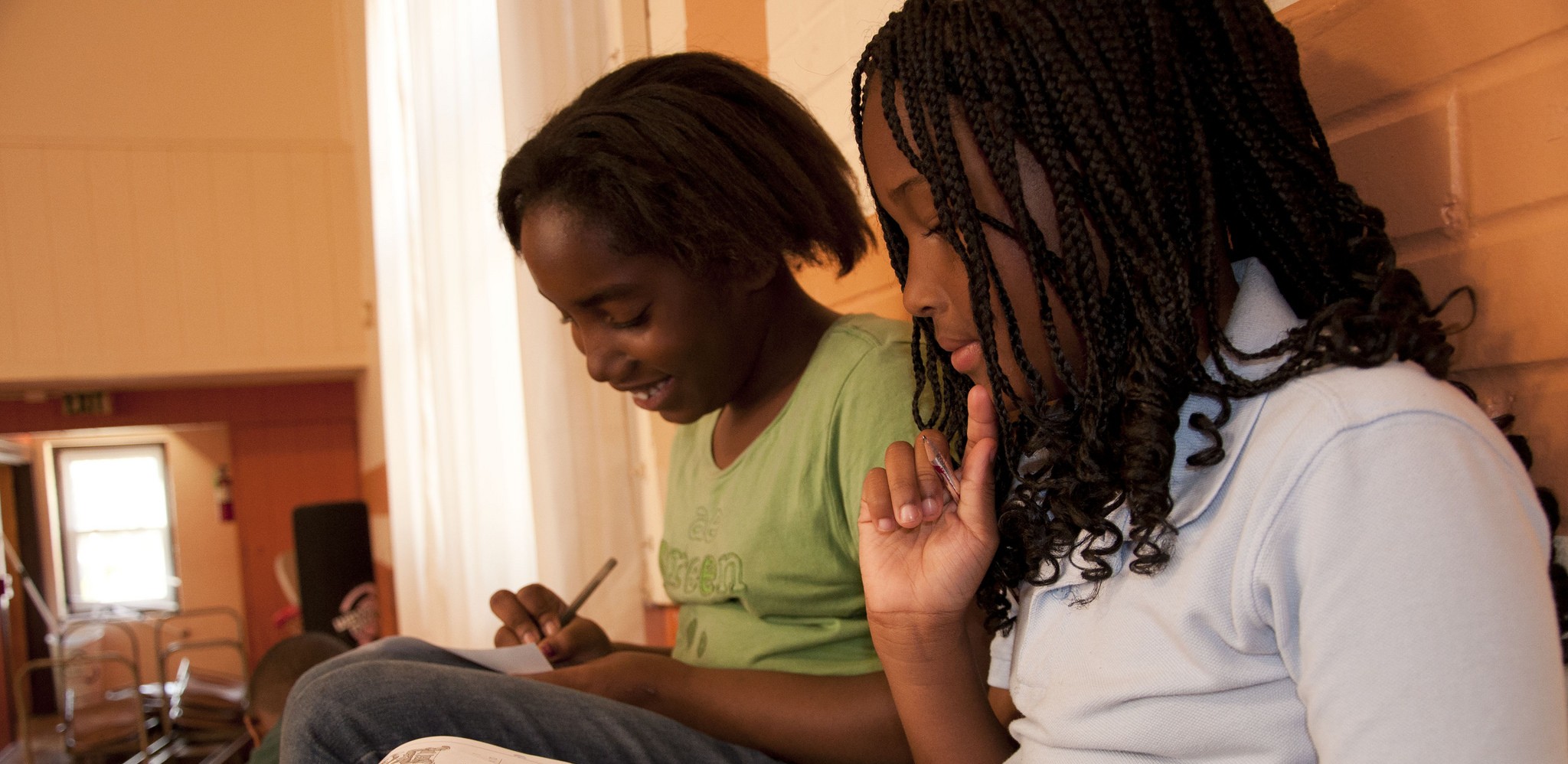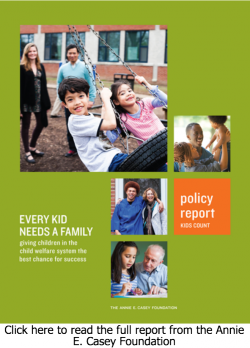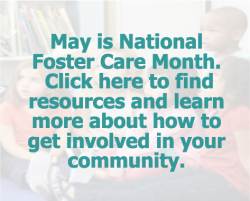The Right Balance – protecting children and supporting families – the right to grow up in a nurturing home.
All children deserve a family. All children also deserve effective, high quality, developmentally appropriate care to address whatever issues they face. A child in foster care is no different. So, when they are facing issues so severe that their safety or those with whom they live are at risk, when foster parents are at a loss as to how to help after trying other measures, residential treatment may be the best option. Residential treatment is a tool to address multiple and complex, high acuity behavioral health issues in a safe environment, while working with the caregivers on how to successfully transition to home.
Darren’s birth mother used crack cocaine while breastfeeding him. When she would go out she kept him in a closet. Even after going to a loving and nurturing foster and then adoptive home, he found himself filled with rage, threatening people and putting holes in walls. In desperation, he tried to kill himself. Madelyn, the adoptive mother, had no idea how to help him. She reached out to a residential treatment agency, who worked with Darren, Madelyn, and even his teachers. Darren began to address his grief and loss, and the resulting anger. Madelyn learned new tools on how to engage Darren and respond when he was struggling. They accessed community based supports for when he returned home, to support him as he continued to progress. Darren is on pace to graduate high school on time, and is taking Advanced Placement classes in preparation to go to college in the fall.
“The ultimate goal is to find permanency for every child. First and foremost through reunification with their family and if that’s not possible then a forever family through adoption or guardianship” – Julie Lester, Deputy Director, Missouri Department of Social Services, Children’s Division
This month, Missouri KIDS COUNT is partnering with The Annie E. Casey Foundation (AECF) on their most recent report, “Every Kid Needs a Family”, which provides a comprehensive look at children in the foster care system, calling on states to reduce the number of children in group placements, the environment least like a family and home.
Click here to read the full pdf from the Annie E. Casey Foundation
There are 1.3 million children in Missouri – 13,038 of those children are in the legal custody of the state. As of March 31, 2015, 10% are in group placement or residential setting, 3% are in mental health/medical facilities, treatment foster homes managed by residential providers, detention, kinship or runaway status. The remainder of the 13,038 are in foster families or kinship/relative care.
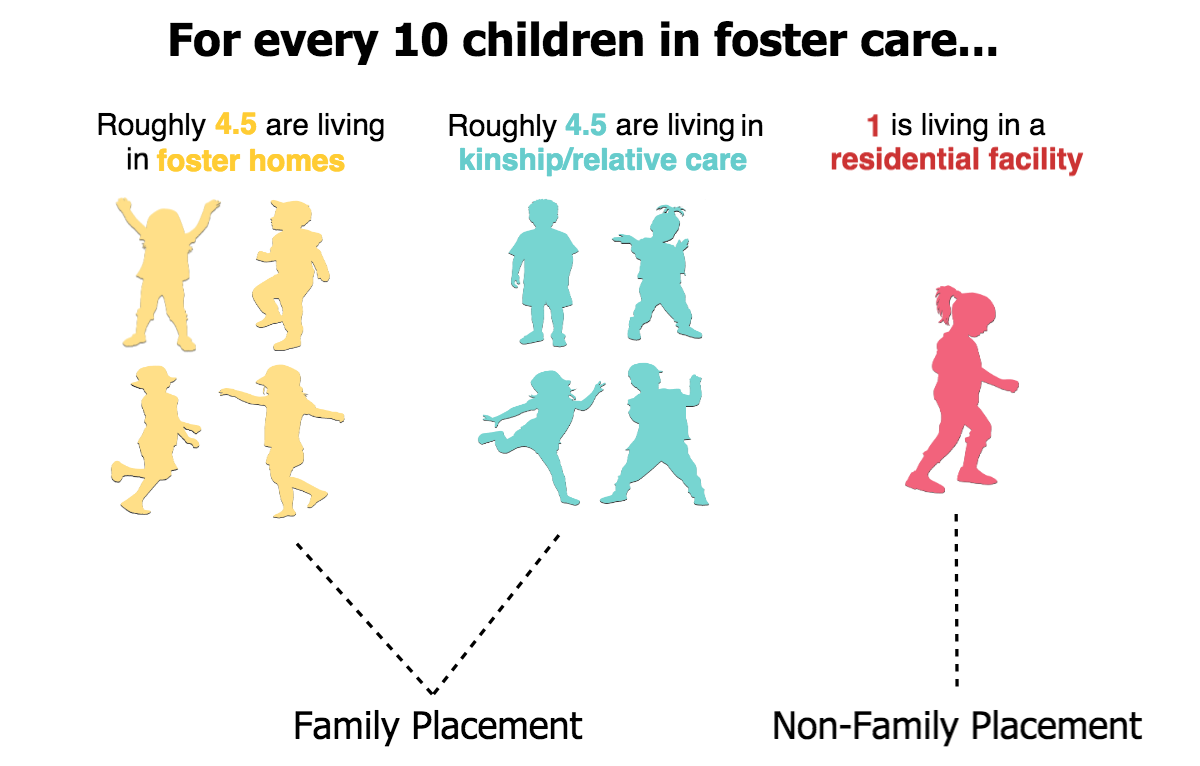
The number of children in care who are without an identified adoptive resource has declined significantly over the past 10-15 years to roughly 1,200 of the 13,038 in care. An additional 1,000 children are awaiting finalization of their adoption with a relative or foster parent. The remainder are working on a reunification plan with their biological families.
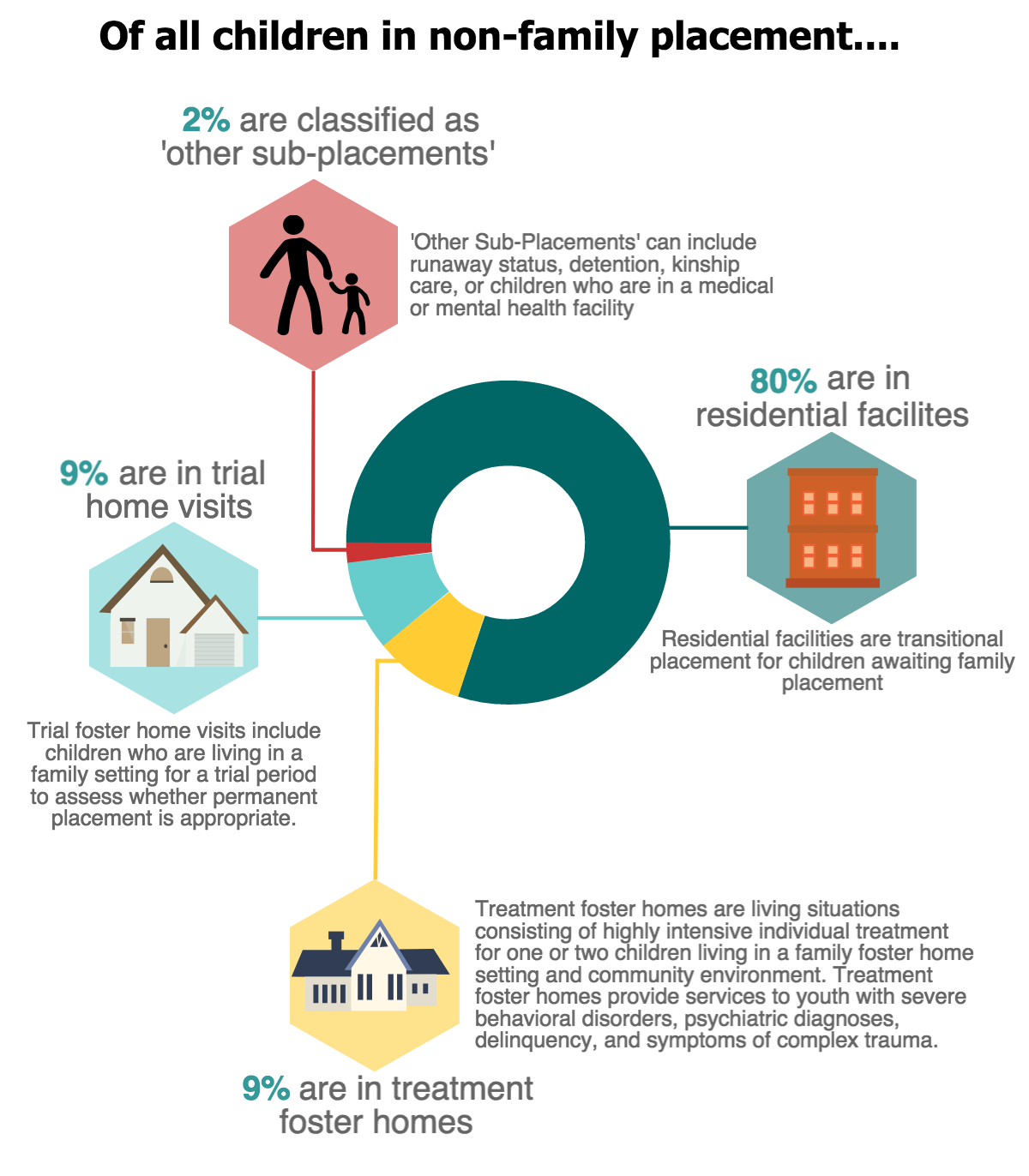
The data from Annie E. Casey show that among all states, Missouri ranks in the top 20 states that have the highest number of children in state custody placed with families. Missouri also ranks in the top 20 states with the lowest number of children in non-family placements.
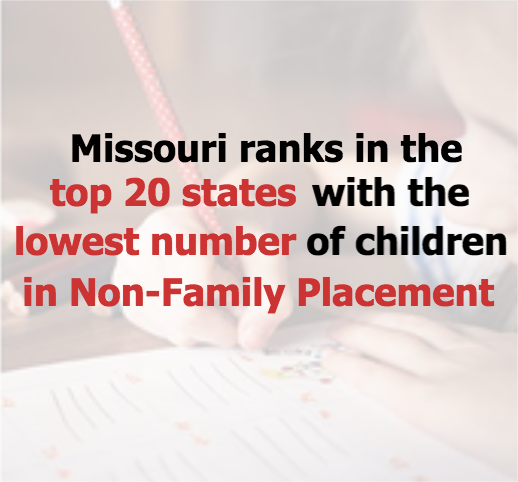
Recommendation 1: Expand the service array to ensure that children remain in families
Missouri is constantly improving or expanding services to ensure children remain in their family home whenever possible. When family challenges are brought to the attention of the Children’s Division, service workers are assigned to work with families to assess the area of challenge and level of risk and provide families with the support to remediate challenges while maintaining safety of the children. Support often includes making referrals to appropriate services within the community to address those challenges.
When children are at imminent risk of being placed in foster care because safety cannot be assured the Intensive In home Service (IIS) program is accessed. The IIS program functions to modify the home environment and/or family behavior so that the child may remain safely in the household. Services are focused on assisting in crisis management, restoring the family to an acceptable level of functioning, and gaining support within their community to remain safely together.
During the 2014 legislative session, the budget for the Children’s Division was increased by $5.1 million, in recognition of the need to improve the environment for staff who work with children at risk. The funding has allowed Children’s Division to create a career ladder to offer better pay and increased opportunities for frontline staff, provided improved technology for workers in the field (use of iPads), and train staff on secondary traumatic stress. Much of this work has already begun with the objective of strengthening the investigation/family assessment process. The Division has contracted with Missouri KidsFirst to provide Gunderson National Child Protection and Training Center ChildFirst curriculum to all investigation and supervisory staff. Division staff began this training in January of 2015 and will continue throughout the year.
Missouri Children’s Division is working to become a trauma informed agency using the National Child Traumatic Stress Network Toolkit to train staff as well as foster parents. Trauma Specialists have been identified in each region to assist with this training and become champions for trauma informed care. In addition to training staff, the Division is reviewing policies through a trauma lens to ensure they support a trauma focused reaction to case management and do not unintentionally cause further trauma. Click here to learn more about trauma informed care and the National Child Traumatic Stress Network.
In March of 2015, Missouri Children’s Division was re-accredited by the Council on Accreditation. Accreditation means that the Children’s Division has demonstrated success in reaching high performance standards in service delivery to families and children, accomplished by only four other states in the nation. To find out more about the accreditation process, click here.
Missouri Children’s Division works closely and effectively with the Missouri judicial system and CASA. CASA, Court Appointed Special Advocates, are volunteers appointed by a judge, supervised and supported by professional staff, to advocate for the best interests of abused and neglected children in court. Children with a CASA volunteer are substantially less likely to spend time in long-term foster care, and less likely to re-enter the foster care system. More services are ordered for children and families when a CASA volunteer is assigned. The CASA programs serve specific judicial circuits, which consist of one or more counties. Missouri currently has 21 CASA programs serving 42 counties and St. Louis City.
To find out if your county has a CASA volunteer program, click here.
For more information about CASA volunteers click here.
Recommendation 2: Recruit, strengthen and retain more relative and foster families
Missouri Children’s Division is involved in an ongoing effort to strengthen the plan for recruitment, and retention of relative and foster families. During the past three years the Division, in concerted effort with stakeholders, federal partners and staff have worked to refine recruitment of relative and foster families and develop training designed to strengthen capacities and retain these essential resources.
Thanks to the Missouri legislature, in 2013, subsidies available to adoptive parents were extended to a qualified relative of a child or a qualified close non-related person who is granted legal guardianship of the child. This widens the pool of potential adoptive families for children in foster care.
The CD also has a strong public-private partnership with the Adoption Resource Centers (ARCs) around the state.
- The Midwest Foster Care and Adoption Association, serving the western side of the state with offices in Springfield and Kansas City,
- The Central Missouri Foster Care and Adoption Association with an office in Jefferson City, and
- Foster Adoptive Care Coalition, which serves the eastern part of the state with an office in Brentwood, MO.
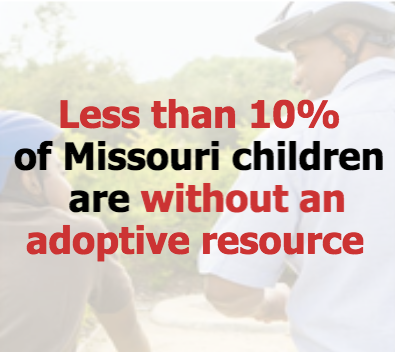
Recommendation 3: Support decision making that ensures the least restrictive placement
When removal of a child from his/her home is necessary because safety cannot be assured, the Division immediately begins searching for family or kin with whom the children can reside. Placements are identified with family/kin with the intent to preserve family connections and whenever possible to assure as little disruption as possible to the everyday routine of the children including working to maintain children in the same community, school district or childcare.
When the decision is made that children/youth, because of the circumstances that resulted in their removal, have behavioral issues that would likely be served best in a residential care setting, they are screened through a Children’s Division Residential Care Screening Team Coordinator. This screening occurs after the Children’s Services Worker has completed a comprehensive screening form to assess the level of care necessary to assure treatment. It is important to remember that youth who are placed in residential care frequently have behavioral issues with an accompanying mental health diagnosis. Because these youths’ problems are often caused or exacerbated by trauma, the Division will be providing trauma training throughout the organization.
Residential treatment providers are also increasingly trauma informed, and many have certifications in models of care for responding to trauma, and also in being a trauma informed organization. Treatment providers work to increase use of evidence based and evidence informed care to improve outcomes and child well being.
Private Foster Care Case Management organizations are required to be accredited through either Council on Accreditation, CARF or the Joint Commission. These case managers are involved in regular review of treatment progress. Treatment review teams work together to ensure the treatment is most appropriate and that the child will transition to the most home like setting possible upon discharge.
The Value of Prevention: investing in and strengthening families early on:
Child Abuse prevention works, and Missouri is home to several proven and effective programs that are keeping families whole and helping children thrive in safe, loving homes. A few examples of these programs are:
Parents as Teachers
Parents as Teachers (PAT) helps families with children during the critical years of a child’s life from conception to kindergarten. Started in Missouri, PAT develops curriculum to support parents and children, training professionals to be support systems for struggling families, and advocates for children and families through early intervention, shaping policy around evidence based practice and emphasizing school readiness. Click here to learn more about PAT.
Home visitation
Research shows home visiting programs are among the most effective programs in preventing child abuse and getting at risk families off to a good start.
The Missouri Department of Health and Senior Services’ (DHSS) Home Visiting Programs contract with local agencies to provide voluntary early childhood home visitation services, ensuring children have the opportunity to grow up healthy, safe, ready to learn and able to become productive members of society. This is accomplished through the implementation of high quality, evidence-based, early childhood services.
Enrolled pregnant women and/or primary caregivers and their children are served from birth up to kindergarten entry and are individually assessed for all areas of need, assisted in obtaining services to address these needs, and provided home visiting services which support, educate, and enhance their parenting skills and parent/child relationships.
The goals of the DHSS Home Visiting Programs are to: improve maternal and newborn health; reduce child injuries, child abuse, neglect or maltreatment and reduce emergency room visits; improve school readiness and achievement; reduce domestic violence; improve family economic self-sufficiency; and improve coordination and referrals to other community resources and support for families. Last year, over 1700 families were served.
To find a program in your area, visit the website.
One of the many successful programs is Cornerstones of Care Healthy Families Home Visitation Program.
People do better when they know better. Cornerstones’ Healthy Families Program helps expectant and new parents manage the stressors that contribute to the maltreatment of children. At-risk mothers and mothers to be stand the greatest chance of abusing their sons and daughters and having those children removed from their home. Their chances of success as parents are greatly enhanced when they seek in-home education and parenting support, such as is available through Healthy Families. Cornerstone’s program is the first in Missouri to be accredited by Prevent Child Abuse America (PCA America).
Healthy Families Home Visitation Program provides high quality home visiting services to families who want to improve their children’s health, nutrition and developmental outcomes. It works with soon-to-be and new parents, helping them gain the skills they need to successfully raise their children.
For information on how to access or support prevention programs in your community, call 800.942.0326 – Missouri Coalition of Children’s Agencies.
Head Start
Head Start was established in 1965 to help low-income families provide their children with developmentally appropriate education, health and social services to better prepare them to achieve in school and society. As a national child development program for children from birth to age five, Head Start provides services to promote academic, social and emotional development, as well as providing social, health and nutrition services for income-eligible families.
Click here to learn more about Head Start in Missouri.
Strengthening Families Initiative
The Strengthening Families framework, developed by the Center for the Study of Social Policy (CSSP), focuses on increasing family strengths, enhancing child development, and reducing child abuse and neglect. It is based on engaging families, programs and communities in building five protective factors:
- Parental resilience
- Social connections
- Knowledge of parenting and child development
- Concrete support in times of need
- Social and emotional competence of children
These five protective factors help families succeed and thrive. There are numerous resources available to parents, professionals, and practitioners that can strengthen these five areas, including the CSSP’s website.
The Missouri Department of Mental Health–Project LAUNCH, Missouri Department of Health & Senior Services–Early Childhood Comprehensive System, Missouri Children’s Trust Fund, and University of Missouri Extension work together to provide trainings on the protective factors for parents and professionals across the state. Many of the materials including an on-line training are available at www.ctf4kids.org.


Foster Care Data by County
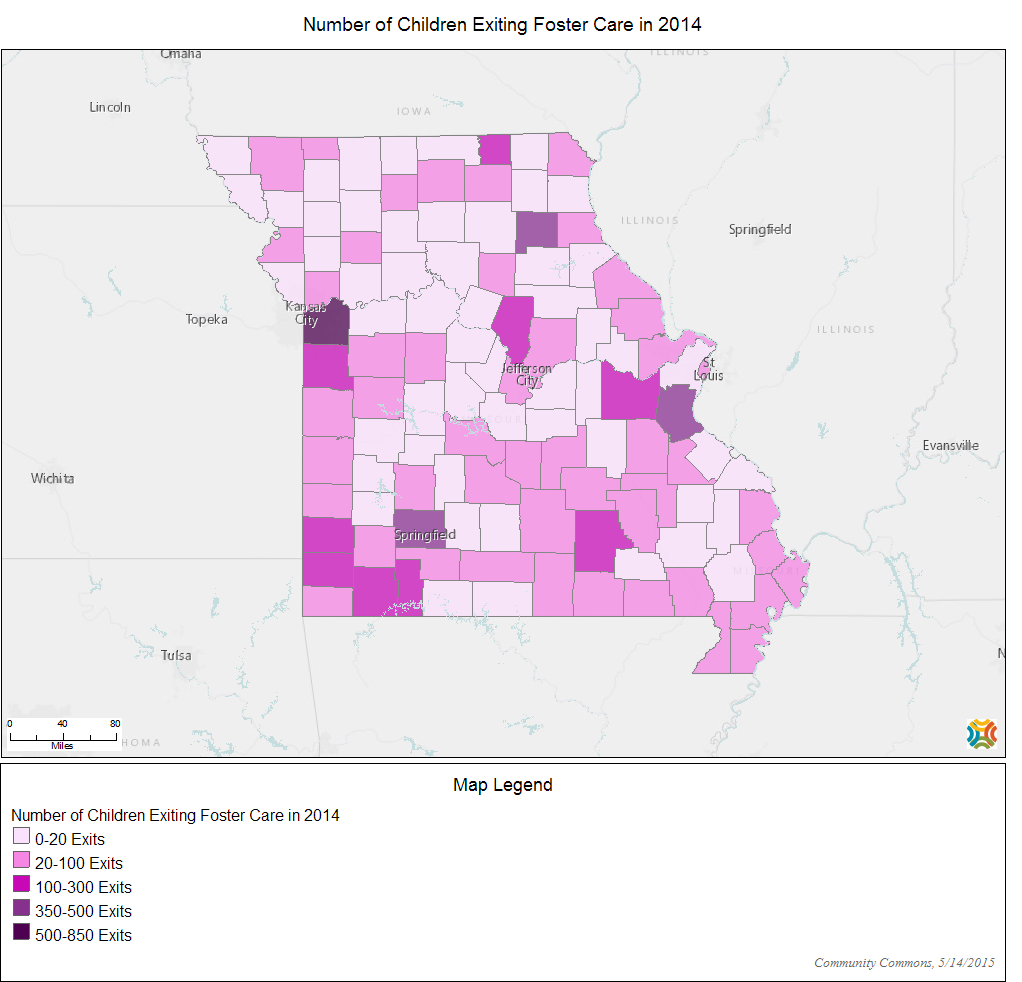 This map shows how many children, on average, exited the foster care system in each Missouri County in 2014.
This map shows how many children, on average, exited the foster care system in each Missouri County in 2014.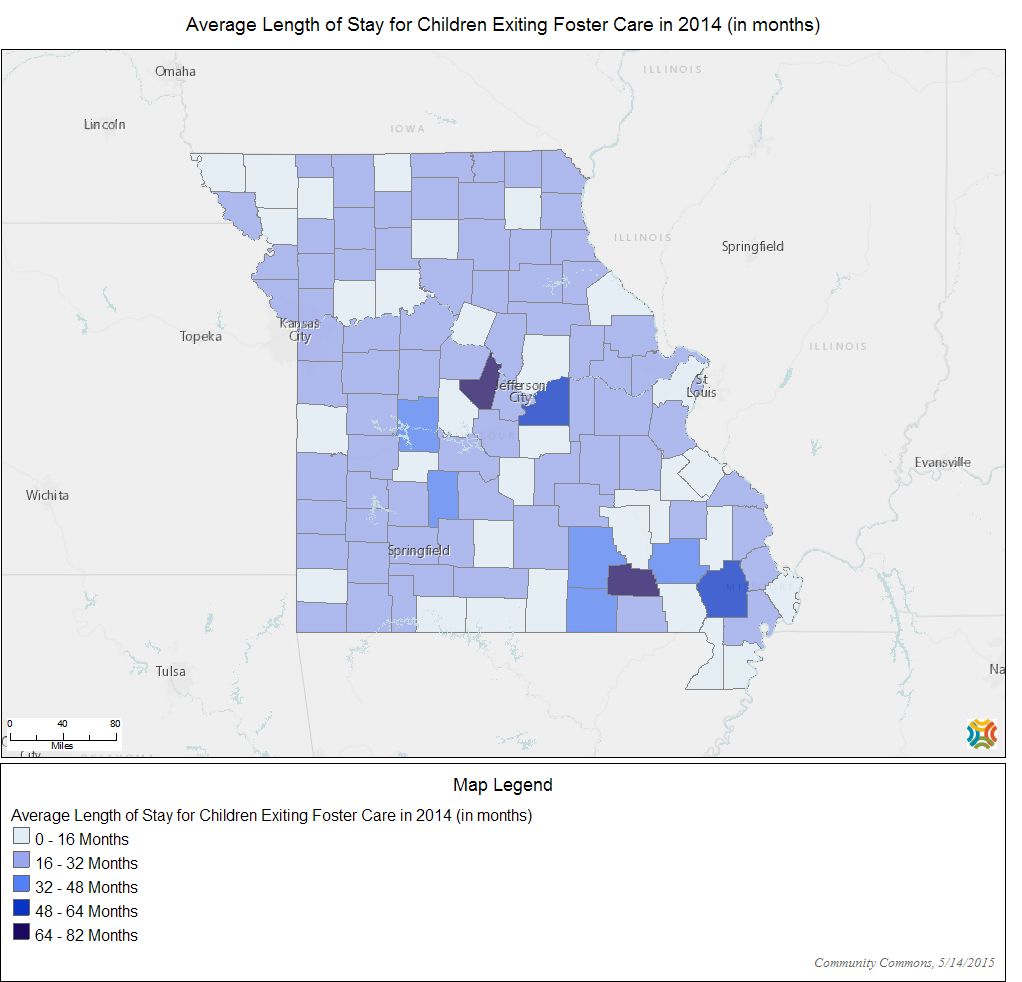 This map shows, on average, how long children who existed that foster care system in 2014 were in state custody.
This map shows, on average, how long children who existed that foster care system in 2014 were in state custody.May 19, 2015

